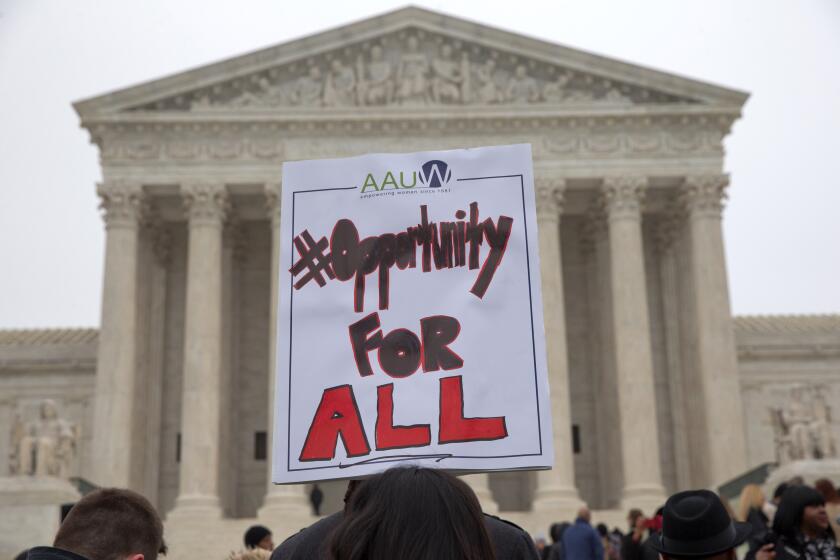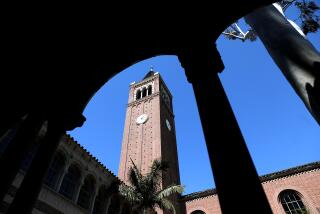Commentary: Ending affirmative action won’t level the playing field. It took me over 30 years to do that for my family

- Share via
My son chose “Hispanic or Latino/a/x” in the demographics section of college applications he began filling out two months ago. It was an easy decision for him, though I have quietly agonized over this one box for years. I have encouraged him to excel academically so that no one could claim he had gotten into college because of his ancestry.
As someone who benefited from affirmative action to get into college, I have heard all the ugly insinuations from critics of the policy that considers race and ethnicity during the admissions process. How I didn’t deserve to take up the spot of someone with better academic qualifications. How life must be easy for me since I can check the “Latino” box and automatically get scholarships, awards, jobs, etc.
Opponents of affirmative action argue that simply by eliminating the “race/ethnicity” consideration, the college admission system will automatically convert into a level playing field for all students. Reality is far more complex, as I have discovered now that I’ve experienced the American college journey both as a low-income, first-generation student and, decades later, as a well-educated, middle-class mother shepherding my kids through the same process.
I never thought of myself as disadvantaged while learning English and living in an immigrant household in Santa Ana with few economic resources. It’s only now, as I help my son navigate the college application process, that I’m fully learning what an uphill climb I had throughout my educational path.
Guerrero: Affirmative action cases aren’t about ending discrimination. Their goal is white supremacy
The group behind two Supreme Court cases is deeply linked with prominent white nationalists. That shows the real agenda behind the legal push.
Affirmative action, which allows college admissions to take into consideration the race or ethnicity in ranking applicants, is a policy that engenders mixed feelings. Opponents say it bestows an unfair advantage. Supporters like me grudgingly accept it as a corrective measure that we wish was not necessary. Either way, affirmative action is on shaky ground in the Supreme Court.
Legal experts believe Supreme Court justices appear ready to strike down the policy after hearing oral arguments Oct. 31 in two lawsuits filed by Students for Fair Admissions against Harvard and the University of North Carolina at Chapel Hill. The group behind the lawsuits was formed by activist Edward Blum, whose failed 1992 congressional bid prompted him to file a successful lawsuit against redistricting that maximized Latino and Black political representation. If the court’s six-justice conservative majority favors the argument by the plaintiff that considering race as part of an evaluation of someone’s qualifications violates the 14th Amendment’s Equal Protection Clause, it could have far-reaching implications at all higher education institutions and workplaces that consider diversity.
As Justice Sonia Sotomayor noted at the argument: “You’re assuming in your argument that race is the only factor that gets someone into a school.” She added, “sometimes race does correlate to some experiences and not others. If you’re Black, you’re more likely to be in an under resourced school. You’re more likely to be taught by teachers who are not as qualified as others. You’re more likely to be viewed as less academic — as having less academic potential.”
The fact remains that a majority of Native American, Latino, Pacific Islander and Black students suffer from disadvantaged socioeconomic conditions and other factors that affect their academics. Further, these conditions are often the result of policies that have hindered these communities, such as immigration policies that are discriminatory, racially restrictive covenants that spawned overcrowded housing, and disciplinary policies in schools that are unfairly applied to Black and Latino students. Affirmative action has been the imperfect answer to these systemic inequities.
When race can no longer be considered for college admissions, equity advocates must take aim at the root causes of educational inequality.
Growing up, I was a bright student whose fondness for books helped me learn English quickly, but I navigated my educational career mostly on my own. My parents expected me to go to college, but their lack of familiarity with the U.S. educational system hampered their ability to help me. They never attended parent-teacher conferences because they didn’t speak English or school functions, such as my track meets in junior high, because of inflexible work schedules in the factories where they worked. Nevertheless, I felt their love and emotional support, which drove me to do my best in school.
Meanwhile, my son and daughter have relied wholeheartedly on my guidance and physical presence every step of the way. I have participated in everything from brainstorming science project ideas and being a room mom in their elementary school years to coaching my son through various drafts of his college essay. I attend all my kids’ cross-country races and track meets in high school. My kids’ bedrooms are filled with medals, plaques and trophies, each one earned in competitions, while I earned one gold medal in high school for language and literature in the Orange County Academic Decathlon.
My son is currently among the top 10 students in his senior class of nearly 750 kids, with an extensive list of extracurricular activities and honors related to his interest in a computer science career, including winning a national championship in cybersecurity. My younger daughter is equally driven, recently starting up a literary magazine by and for teens, in addition to publishing one of her short stories in a book. They have been enrolled in the academically rigorous International Baccalaureate program since middle school.
Being a college graduate has given me the advantage of knowing how best to support and guide my kids’ academic journeys. My kids will not need the special consideration provided by affirmative action during the college application process, though their diverse background is valuable nonetheless. Their dad is white, but they’ve grown up immersed in my Mexican culture. And whatever career field they eventually choose will also benefit from their Latino background. Society benefits from having diverse student bodies, particularly in top universities, to produce workers who can succeed in a diverse workplace.
The landmark Supreme Court case Grutter vs. Bollinger in 2003 reaffirmed affirmative action, allowing college admissions to consider race if other factors also are taken into account. In her majority decision, Justice Sandra Day O’Connor wrote that “race-conscious admissions policies must be limited in time,” further suggesting that affirmative action would be unnecessary in 25 years.
Not surprisingly, conservative justices and the attorney arguing against affirmative action in the current Supreme Court cases have seized upon this time frame to criticize the policy. However, these benchmarks don’t work without systemic overhauls that eliminate all the inequality suffered by students who benefit from affirmative action. For example, increased parent outreach and free tutoring for kids living in disadvantaged areas, and massive expansion of programs such as the Educational Opportunity Program.
In an amicus brief in the Harvard case, the University of California notes that its efforts to create a diverse student body after Proposition 209 eliminated affirmative action in the state have not been entirely successful even 25 years later. It will be 34 years since I graduated high school when my son receives his high school diploma next June. That’s more than three decades of work in my household to try to create a level playing field for my own kids.
More to Read
A cure for the common opinion
Get thought-provoking perspectives with our weekly newsletter.
You may occasionally receive promotional content from the Los Angeles Times.












